One of My Greatest Trekking Adventures
May 2009: I first learned about Papua and its tribes of penis gourded men from a documentary. The idea of a tribe of men wearing nothing but penis gourdes to be honest seemed absurd to me and I couldn’t believe that such a tribe existed. I was determined to find the tribe and visit them because in my travel experiences around the world cultures and customs like this just do not last for very long and is destined for extinction or be assimilated with western civilization like so many of the other unique tribes of the world. The tribe I discovered lived in the highlands of Papua on the island of Iryan Jaya. The area is extremely remote and has virtually no infrastructure. For two weeks my friend Kent and I traveled in the Papuan highlands seeking adventure and tribes of the Dani, Lani and Yali people. This is the story of my Papua adventure.
About Papua
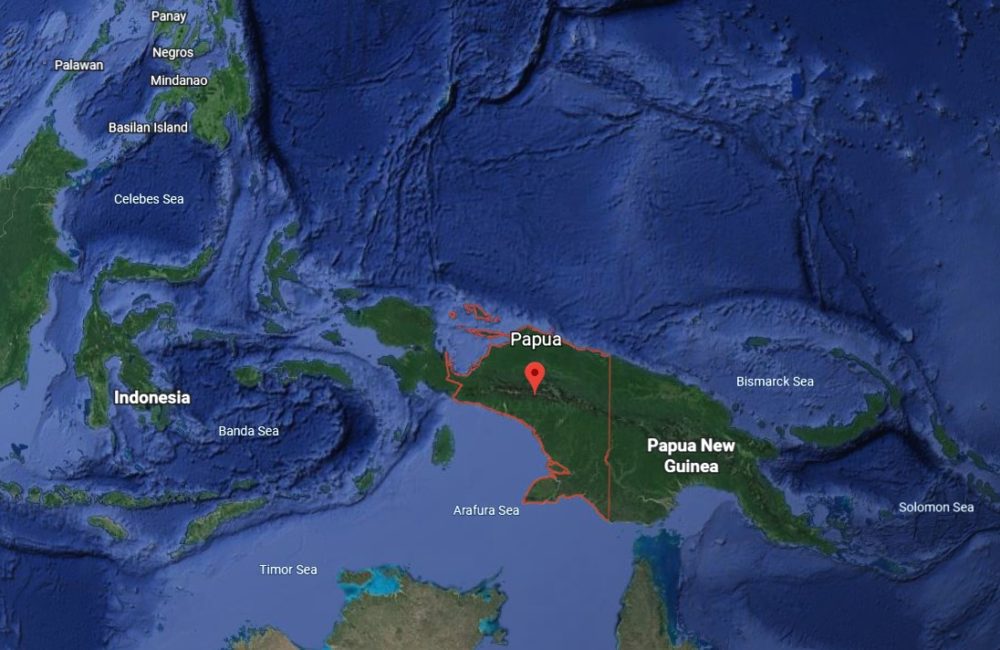
Location of Papua
The island of Iryan Jaya predominantly consists of same Melanesian tribal groups throughout the island but the island is split between two countries. The eastern half is a sovereign country called Papua New Guinea (PNG) and the western half is a province called Papua of Indonesia. Both Papua and PNG are wild with vast tracts of wilderness but Papua in my opinion is even more undeveloped and raw. Papua has more tribes that have had less exposure to the outside world and there are even some claims that there are tribes that remain uncontacted. I am not sure if this is still possible, but Papua is remote, and it isn’t outside the realm of possibility. Over the last few decades, a tribal insurgency has fought to claim independence from the Indonesia government. As a result, Indonesian soldiers are stationed throughout the country and permits are needed to travel to most places especially the interior of Papua.
Preparing for the Journey
Papua was a difficult trip to plan for. Information on the internet was non-existent and the interior of Papua where the tribes are located is wild and I needed to pack all necessities because once there most of these items would be impossible to obtain. I was able to contact a few other travelers via Lonely Planet Thorn Tree forum and gather enough random information to piut together a tentative itinerary. All operators that I contacted were usually middlemen from outside Papua and charged too much money, so my plan was to arrive in Wamena, the capitol of the highlands and organize a trek and local guide there.
Traveling to Wamena
To get to Wamena, Kent and I traveled via Jakarta to Jayapura, the largest city in Papua on the northern coast. We arrived in Jayapura early morning and hired motor taxis to go and arrange permit-surat jalan from the local police station to visit the Papua highlands. The process was hassle free and from the permit office we headed back to the airport to purchase our domestic flight to Wamena on Trigana Airlines, a local airline with a terrible safety record and history of fatal crashes. The tickets could not be purchased online or in advance and were only available in cash at the airport. Luckily there was a flight departing in the afternoon and we were able to purchase a ticket.
The flight to Wamena was over an hour and passed over some very mountainous terrain and large tracts of virgin rainforest. Wamena is a small town in the highlands of tin roofed shacks and muddy roads. it has the feel and look of a frontier town. Indonesian soldiers patrol side by side with the occasional penis gourded tribal man. The first item of business was to register ourselves at the local police station and then find a guesthouse. I had one in mind with a manager I had heard spoke English who had some contacts in town, so this is where I planned to stay. Once at the guesthouse, the manager helped put me and Kent into contact with a few prospective guides and I basically set up interviews to determine which ones would be best suited for us. Once I settled on one guide, and his assistant porter, I drafted an agreement and we both signed the agreement. I paid him only a small percentage up front and the rest was to be paid at the end of the trip.
Trekking in Dani Country
We purchased some food in town, a necessity since later we would discover there was a food shortage in some villages due to a bad harvest. For this reason, I am very glad we didn’t rely on villages for food. The next morning, we set off by bush taxi to Sogokmo village for a few hours until reaching the end of the road. from there we began hiking, crossed the Mugi River and followed the trail of the Dani from the riverside up to Hitugi and Yuarima. Both Hutigi and Yuarima lie on the higher altitude than Wamena. Wamena is about 1,600 m above sea level). We Passed through the hilly terrain alongside Dani home and gardens with sweet potatoes and taro plants.

Dani Villages
The deeper into the interior we hiked and further from the road, the less Indonesian, developed and wilder the countryside became. Villages and people were more traditional. This is why I planned an ambitious trek across the mountains into distant Yali lands where I hoped we would find more people in traditional dress living true lifestyles and not putting on a performance for our sakes. It didn’t take long before we found what we had come seeking. We had hiked for ours and came across a village where people were gathered engaged in drums and exotic song, and smoke was billowing up from pig barbecues. I immediately headed into the village to investigate. Indonesian soldiers, tasked with maintaining security in the region and searching for insurgents, were present watching over the festivities. I wasn’t sure what the occasion was. It was possibly a wedding or some kind of religious festival. Kent and I were the only foreigners as was the case everywhere we went on the trip and some men in penis gourds were present. Most people wore a mix of ragged t-shirts, shorts with traditional clothes. One man had pig tusks pierced through his cheeks and was wearing them in some sort of ceremonial manner.
Pigs were being slaughtered all around us for the festival. They were typically small pigs or wam as they called them and the manner in which they were slaughtered was very interesting. A man would hold one up in the air while another man shot it with a bow and arrow. The pig would be bled to death instead of being given a merciful quick death. The belief I was told is that the suffering equated to better taste in the meat. It was hard to watch the suffering and at times during the trip it was just down right asinine but it was not placed to interfere in their culture.

Dani festival-pig slaughtered
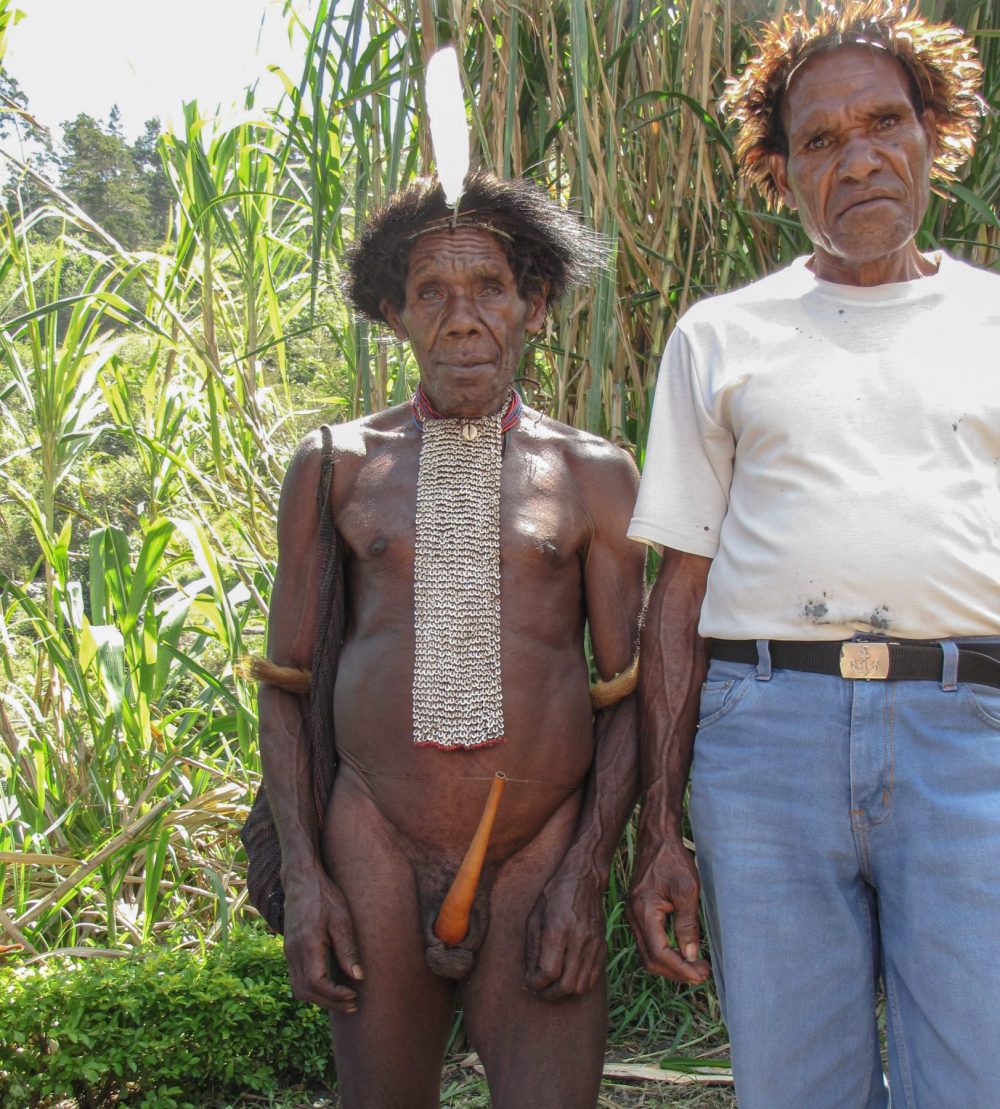
Dani Men

Dani men
After the festival, we continued to climb to the higher altitude and proceed to the border between the Dani and the Yali area. Yogosem and Kiroma are the closest Dani village to Yali area. We passed through the Dani gardens as well as some small forest where the Dani peoples take their wood for building their houses and for fire.
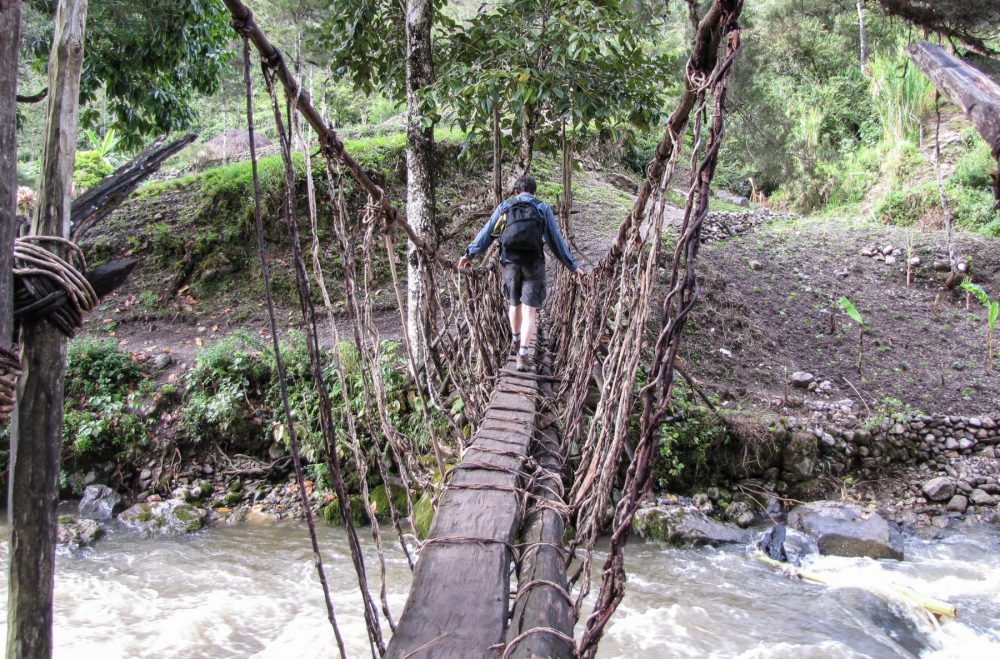
Local bridges

Sweet potato terrace farming located in steep sections of the mountainsides

Dani Village house
Homestay with Pig Fleas
After hiking for about 10 hours and being completely exhausted, it started pouring rain when we entered a village-Kiroma It was cold and raining and we needed shelter and the owner of a local thatched roof house offered to let us sleep inside it for shelter. The idea at the time seemed like a good one but we would learn to regret it. A Dani house is called honai, round in shape, with a place for fire on the center. We slept on the bottom floor while the family slept in a different room of the house. We noticed the pig was kept inside a small little pen in the house. At some point in the middle of the night we awoke itching like crazy and covered in bites. We would discover that the presence of the pig attracted pig fleas and the area was swarming with them. They hopped on and off of our sleeping bags and there was nothing we could do but try and sleep and evacuate the location in morning. Even after we left the house, our sleeping bags were still infested with fleas that would continue to bite me and I would leave my bag out to dry in the sun as often as I could to get rid of the little buggers.

Kent sleeping inside the Dani house

Our roomate for the night
The next morning, we set off early after eating some oatmeal and coffee that I brought with. We hiked all day, and it was a long one. We passed through the highland forest dominated by trees and ferns. We met more Yali people now than Dani. The Yali traditionally wear their penis gourd and rattan hoop along the waist. We crossed some rivers, walked along the riverside and climbed hilly terrain. Most of the walk was uphill. The trail is also the local highway and the only means in which tribal people can travel in between villages. No matter how difficult I considered the trail to be, this was a normal part of life for the villagers who needed to travel to trade or obtain medical assistance.
As we climbed higher into the mountains, the trail conditions grew worse, temperatures colder, and jungle taller and deeper around us. We encountered fewer people but would still on occasion encounter a Lani or Yali tribal group carrying a sack of potatoes to sell. They would always have a colorful stocking hat but nothing else on but a penis gourd. They would always stop to shake my hand and the handshake was long and drawn out sometimes last 20-30 seconds. I was never asked for money for my photos, but we carried cigarettes, which I knew they liked, and I would usually give them a few as a gift as they passed. We also passed some women carrying pigs or kids in colorful net bags. I noticed when shaking the hand of one of the elderly women that she had stumps for fingers. This I learned was a result of custom where when a woman’s husband and male relatives died, she would remove one finger for each f their deaths in memory of them.
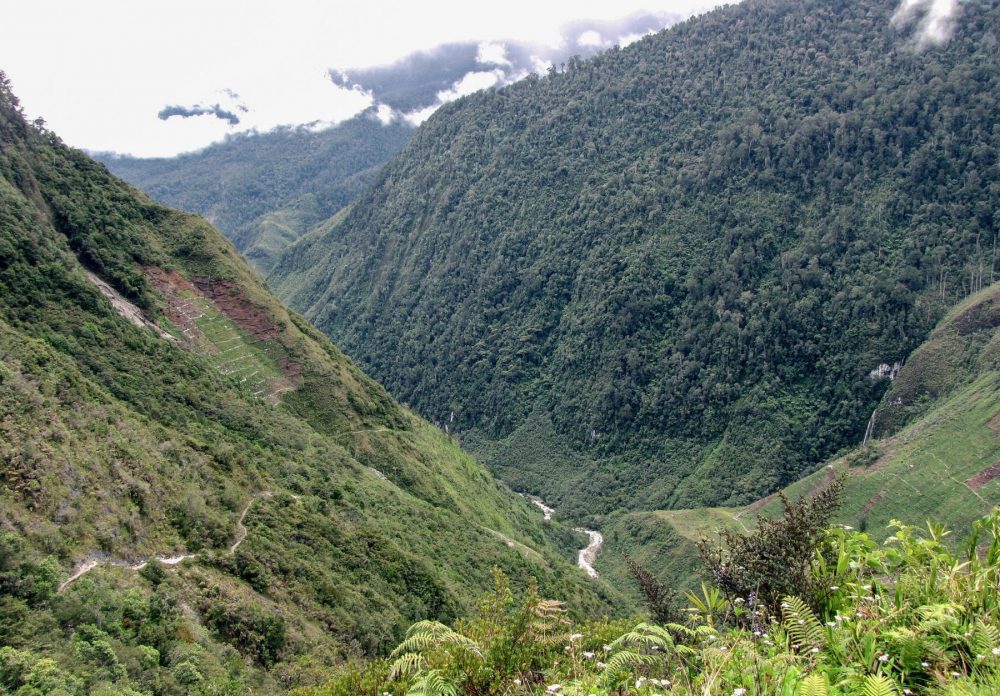
Hiking further uphill
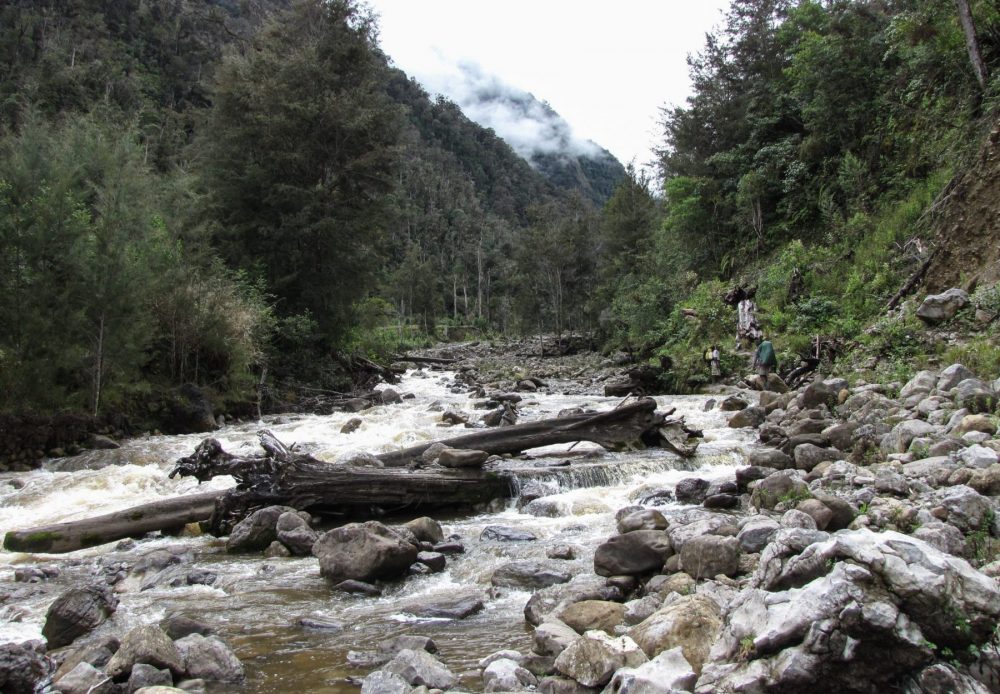
Crossing freezing rivers
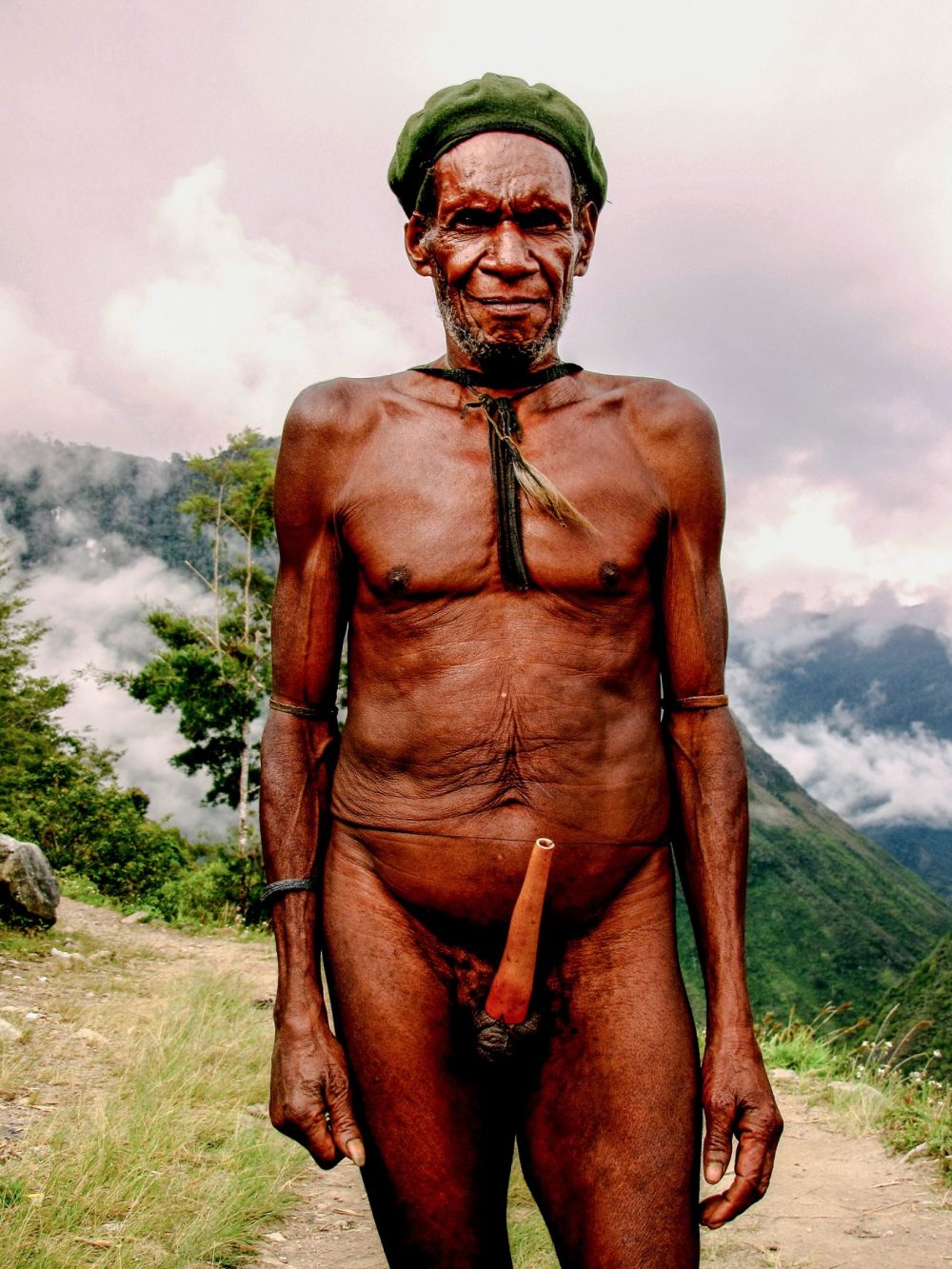
Dani man on the trail

A Dani woman missing one of her fingers from practicing the custom of removing a finger after a male relative dies

Young Dani man we met on the trail

Moses our porter posing with some Dani men on the trail
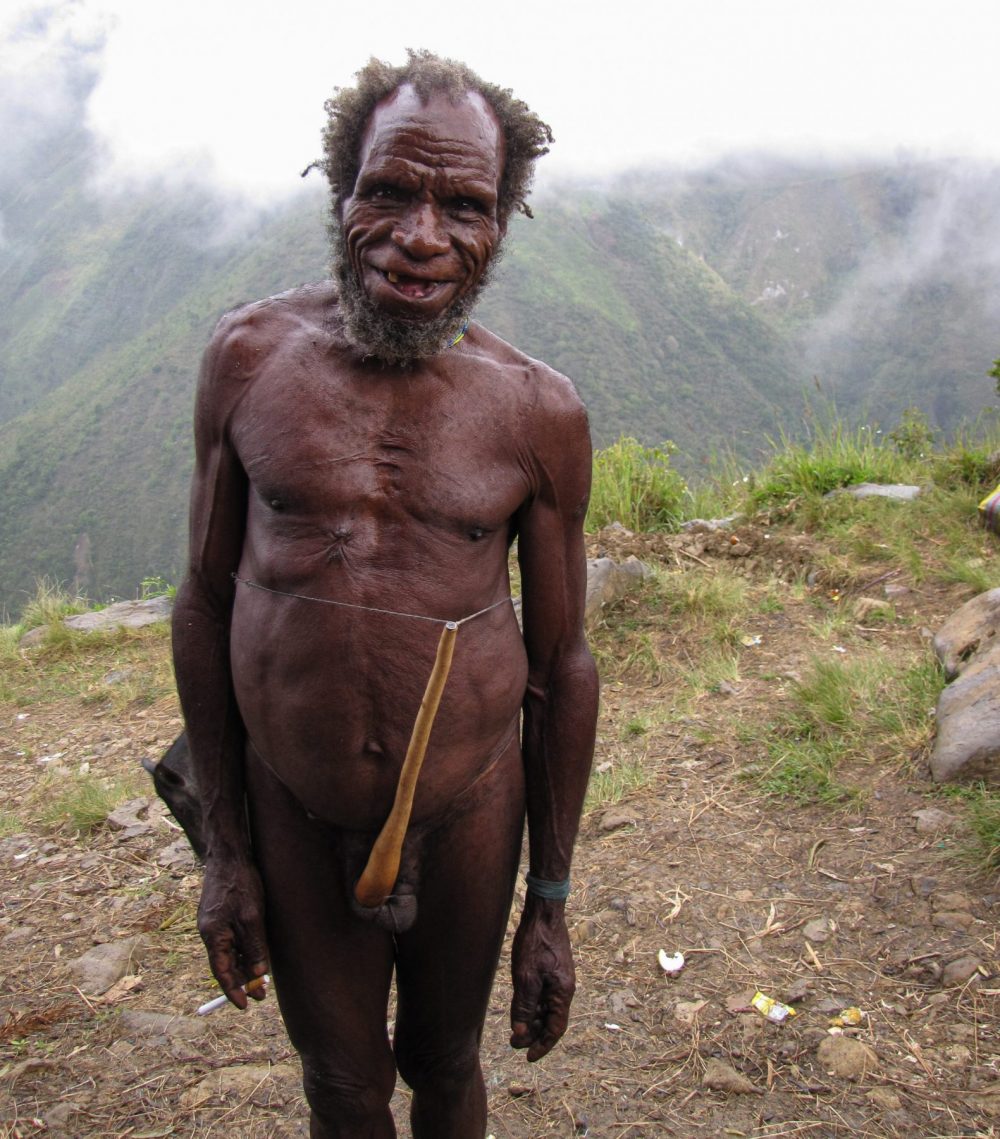
A Yali man we met on the trail

Yali houses in the higher elevations that seemed abandoned

Yali man we met
Sleeping in the High Mountain Swamp Forest
As the evening approached, the temperature became icy and the wind relentless. The walk became extremely difficult, heading through the peatland swamp. We came across occasional makeshift tent camps in the swamps where locals crossing the mountains were seeking shelter for the night. In this area we spotted a few birds pf paradise with lush and ornate white feathers. The trail was muddy and slow-moving and on occasion I would sink to my waste in the mud. There are also soma small rivers to cross. On the summit we were at 9000-10000′ feet of elevation and the freezing rain started to fall, and we ended up seeking shelter with other Yali people traveling across the mountains or hunting in the forests.

View as we came up over the mountain and entered the peat swamp

Peat swamps we crossed
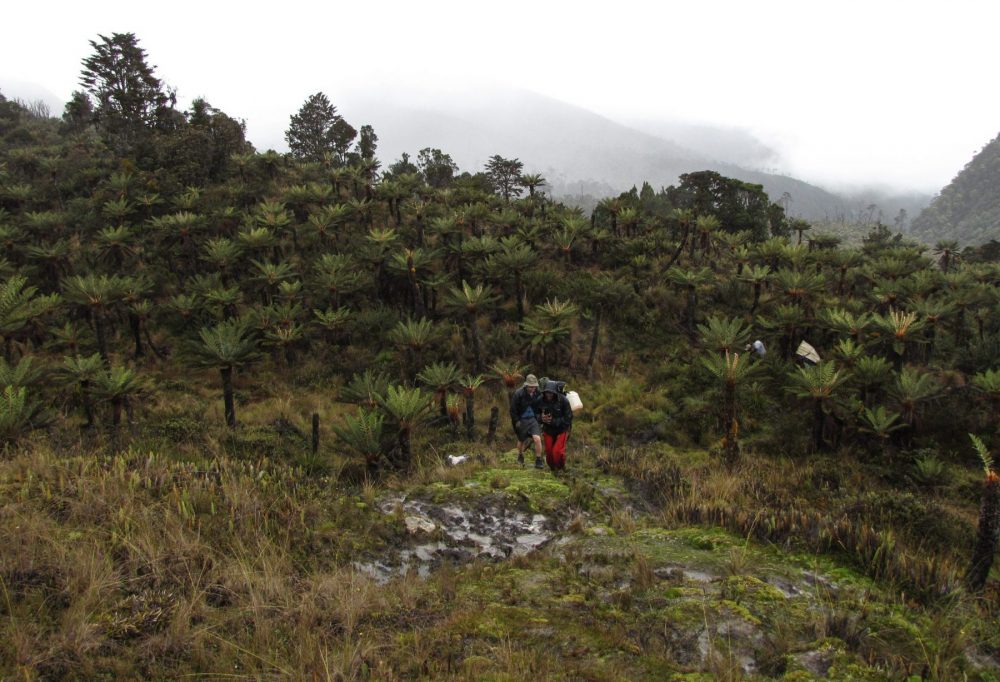
Crossing the peat swamps
It was my birthday, and it was a miserable and difficult day, but it was exactly what I had hoped for on my birthday. Here we were staying in a makeshift shelter at 10,000′ in a mountain swamp, next a warm fire, surrounded by 10 Yali and Dani tribesman. We all had one common goal and it was to stay warm and dry by the fire. I had a readymade cake packed from REI and I mixed it with some water and made some chocolate cheesecake for my birthday and we shared it.

The hunters shelter

Inside the shelter

Inside the shelter
The next morning, we had to cross more swam and then climb down the other side of the mountain into Yali territory. The most difficult thing about the whole hike was knowing we would have to return on the same path to get back to Wamena. The trail was even more difficult and slippery now, passing through some dense forest with tress and giant Pandanus leaves which are used by the locals as food and building material.
It was an all-day steep hike to Solinggul, a village with about 30 – 40 traditional houses. We had to hike in the dark with our head lanterns and cross slippery logs covered in moss. Kent slipped and at some point, injured his knee badly and would later be unable to walk very well.
Finally, late at night we emerged into Solinggul, where many people still wear grass skirt and penis gourds. We sent for the village elder and made arrangements to sleep in a small schoolhouse for the night on the floor on our blow-up mattresses.
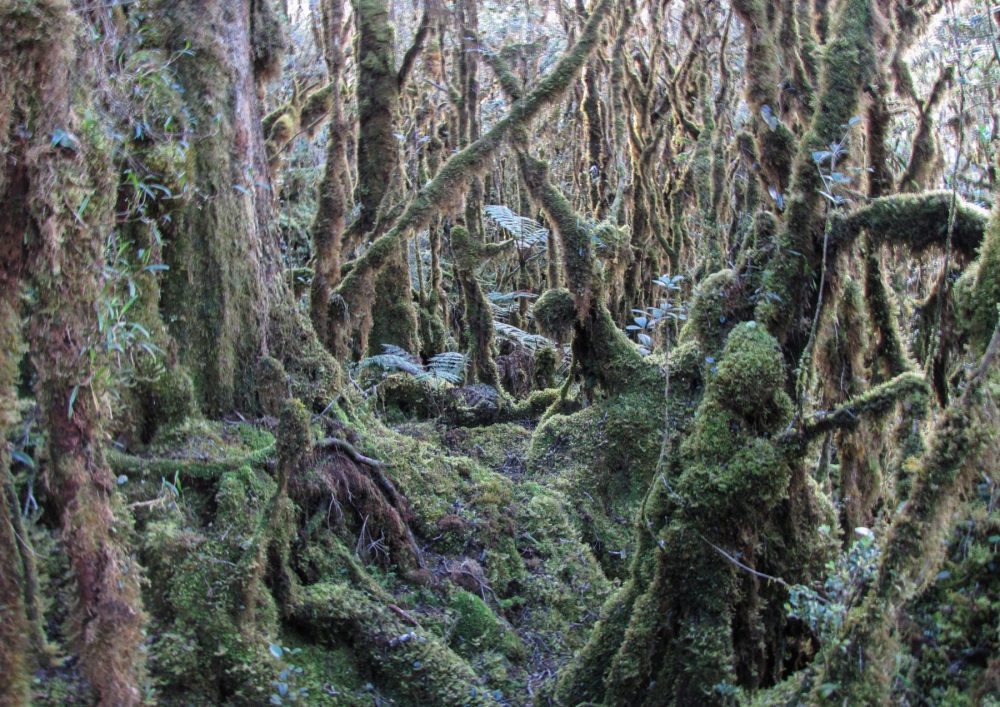
The forest we hiked hours through in the dark to get to Solinggul
Warm Village Reception
Kent and I fell had a well-deserved sleep that night and planned to sleep in, but it was impossible because as soon as the first light of dawn approached, there were at least a hundred villagers waiting outside the school peering into the window and giggling and snickering. Word was out that foreigners were in town, and this was a village that few foreigners have ever visited so we were a novelty. Kent and I opened the door to a rock star like greeting from the village kids. We were drying our clothes, so we stood before them half naked.

Morning greeting from village kids

Happy village kids that came to greet us

Elderly ladies greeting us

me and the village kids of Solinggul

The whole village continued to watch us even as we packed up to leave

Village girl
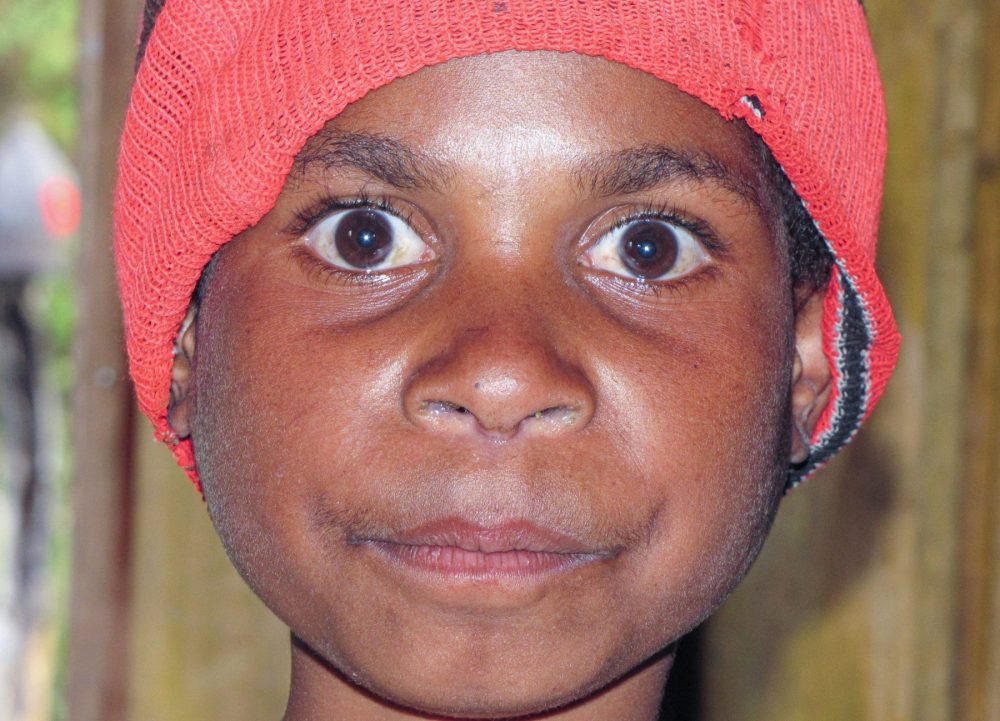
Village girl

Yali man
As we left, we paid the man who owned the schoolhouse or who claimed to own it and he asked for way too much money. This was obviously a case of feast or famine and since foreigners are so rare in these parts, the man decided to overcharge us and I had a very uncomfortable argument with him in front of the whole village that was watching and I ended up paying but less than his asking price, especially since I didn’t want to leave a bad impression on the village of Solinggul . Kent’s leg was injured, and he could barely walk, and we knew he would never make it back over the mountain until he could heal. Unsure as to what the extent of his injury was, we weren’t sure how long it would take for him to heal and our guide convinced us that we could catch a bush plane in the next village on the Missionary Aviation Fellowship, a medical and evacuation flight service run by evangelical missionaries with the purpose of helping the local people especially in these types of villages with no medical services. Our plan was to make a call in the next village to them on the radio and request a pickup on one of their bush planes.
To get to Waniyok we descended about 2 hours on an easy trail and as we arrived in Waniyok we were greeted by throngs of children again. In Waniyok, we made arrangements with village elders to stay in another schoolhouse. Our first order of business was to request a flight from MAF. A dispatcher informed us over the radio that a flight may arrive the next day and they reminded us of what I knew, tourists are last priority behind villagers, and they would pick up only if space was available. The next day the MAF flight never came. Instead, a violent storm came, and it rained and then it poured. Then another day came and went and still no flight. It was becoming clear to us that a flight was not likely to get us.

Me with our constant entourage of children in the schoolhouse at Waniyok
Waiting for the Plane That Would Never Come
We knew that if a plane did come, we would have no advanced notice, so we packed our possessions and tried to be ready at the air strip every day. We ended up spending a lot of time just staring into the empty landing strip. Due to the extreme weather, remote and mountainous terrain, Papua is one of the most treacherous places to fly in the world and MAF pilots have a reputation as being bad ass pilots.
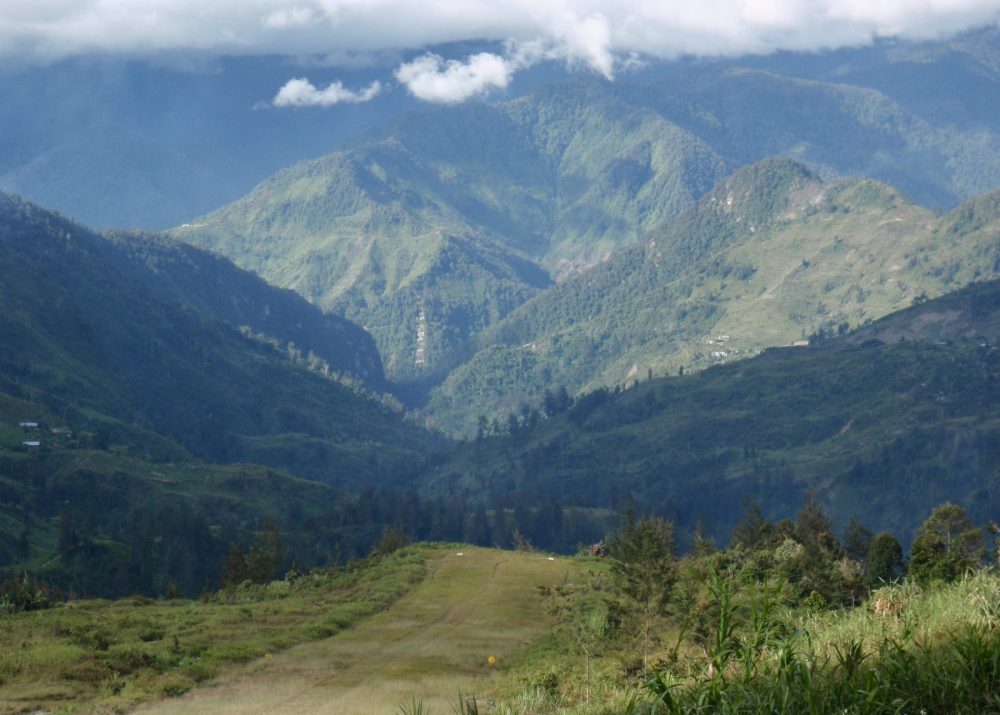
Waniyok airstrip- an uneven grass strip at the end of a cliff
While waiting for the plane or Kent’s leg to heal, which ever came first, we passed the time treating villagers that came to us with injuries, open wounds, or by playing games with the kids or reading. I spent hours everyday teaching kids how to play baseball with a stick and ball of twine and exploring the village and getting to know everyone. But it was stressful to know that we were running out of time. There was a set date for us to need to return by in order catch our international flight home. We needed multiple days to hike back if the plane didn’t arrive and we were running out of time.
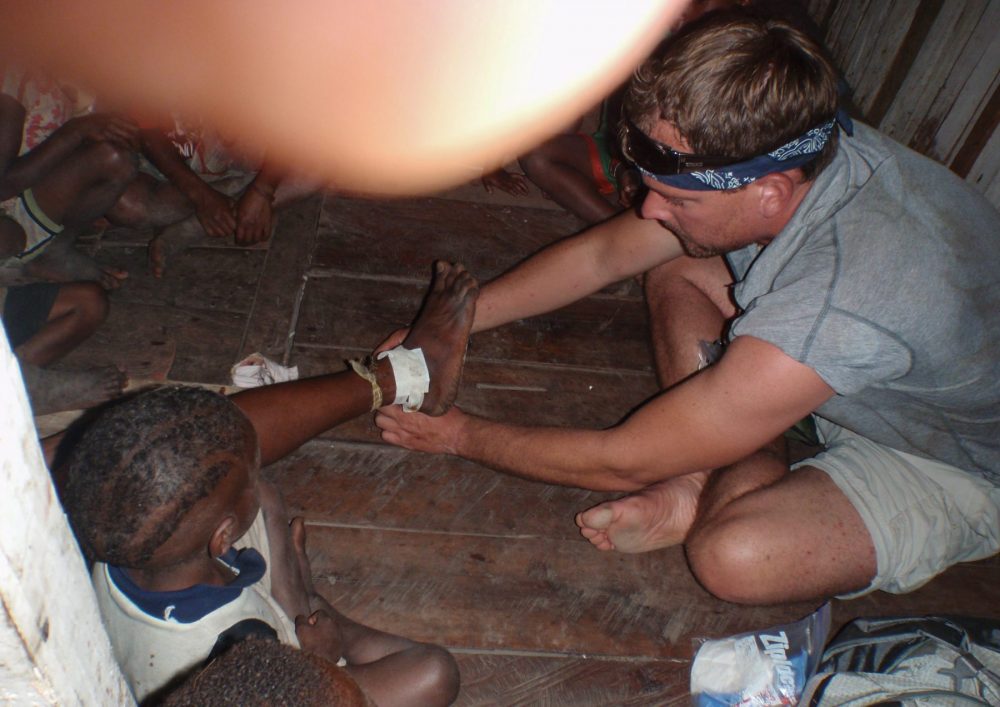
me bandaging a village kid with a wound

Yali woman with rattan skirt
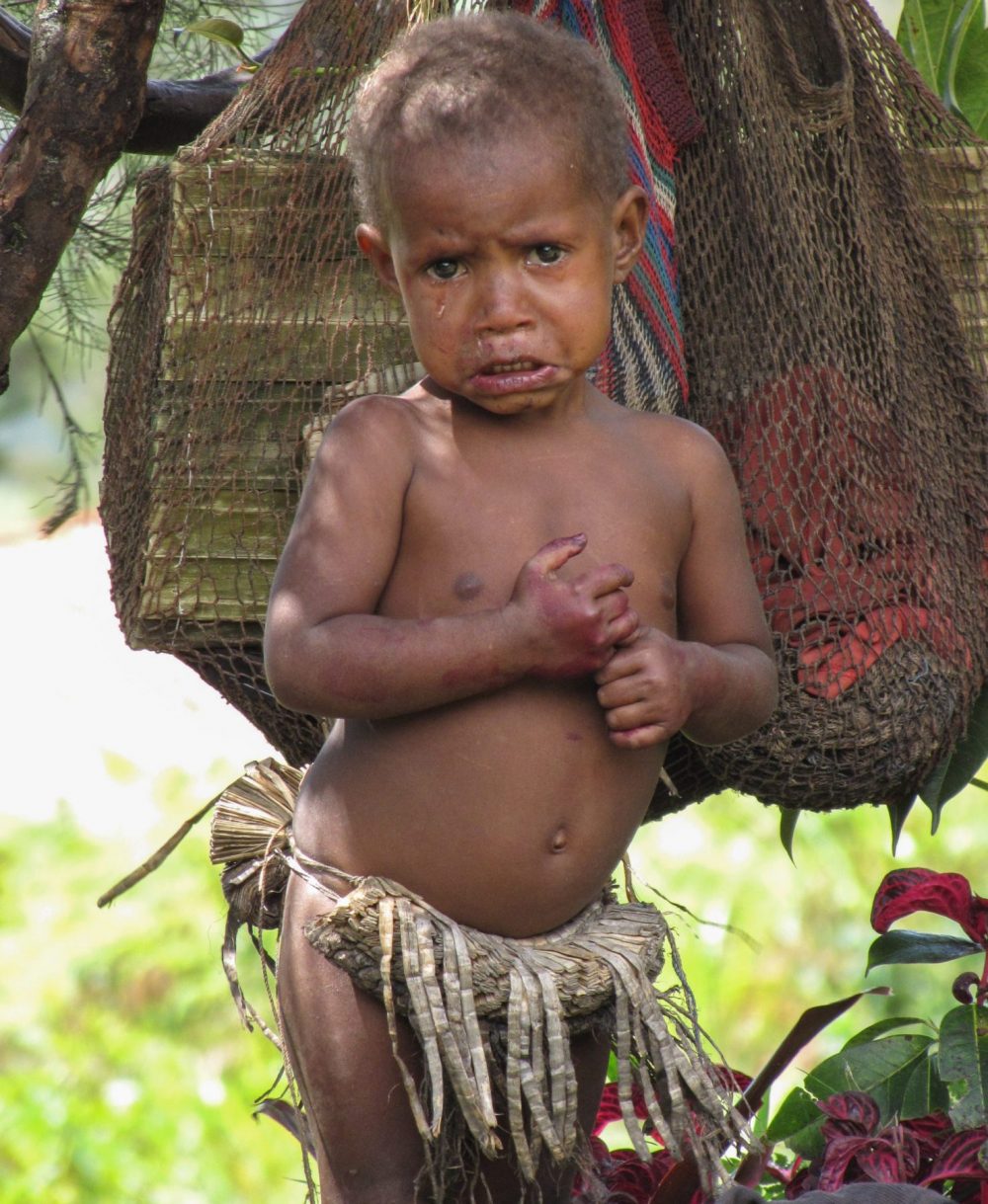
baby with rattan skirt that was terrified of me

Amazing what shirts you find when traveling. It was a good thing the kid and his parents had no idea what the shirt meant
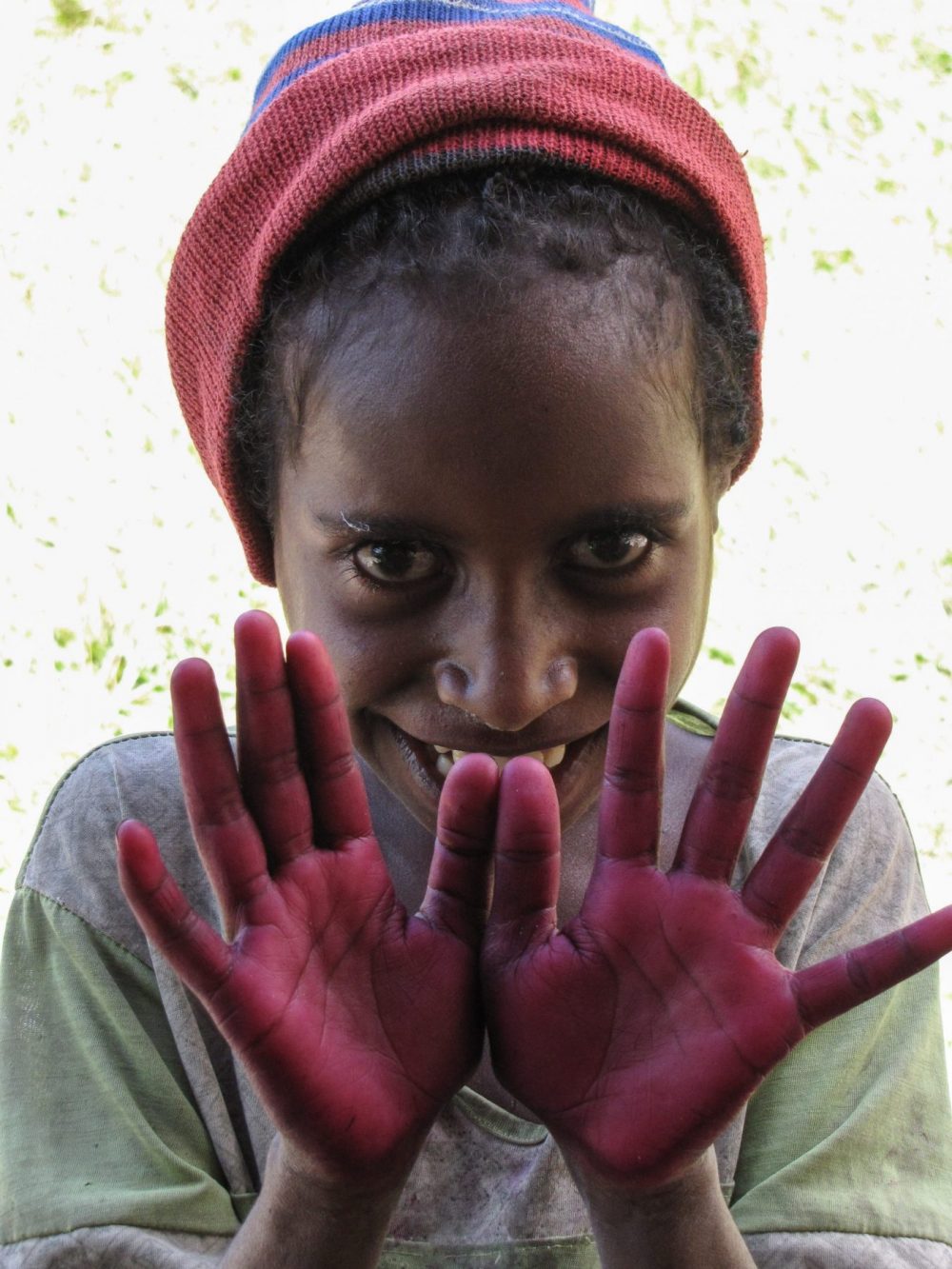
Girl playing with naturalplant dyes showing me her dye hands
We called MAF again on the radio and again we were told they would pick us up the next day and again all night it rained and the constant barrage of rain pelting the tin roof kept me up worried that no plane would arrive again, and it was our decision day. If we waited any longer and the MAF plane did not come, we wouldn’t have enough time to hike back to catch our international flight. To our dismay, the next day the flight didn’t arrive, and we looked up at the mountain we hiked over a few days before in terror. Kent was still not ready to hike, and our guide convinced us that the town of Prongolli, much larger with a bigger airstrip, had a much higher likelihood that MAF would land to pick up some local passengers the following day. With this in mind, we decided to roll the dice and try our luck with a MAF flight in Prongolli knowing that if the flight again didn’t arrive, we would not make it back to Jayapura on time to catch our flight home.
Kent and I along with our guide and porter left Waniyok, said goodbye to our friends and began the 7–8-hour hike to prongolli passing small rivers, forest, and small Yali villages, gardens before finally crossing the Sule River before arriving at Prongolli. The highlight of the hike was when we crossed a Yali village that seemed to be having some kind of religious ceremony in progress. Although many Yali have been converted to Christianity by missionaries, they still practice their traditional beliefs and the village we just entered was in the midst of some kind of ritual to heal sick person. A few dozen people were gathered around a sick person while a couple of penis gourded men ranted in a kind of prayer. When Kent and I arrived, the villagers quickly asked us if we had medicine for the sick individual. It was hard to say what was wrong the sick man, and I only had some painkillers, anti-diarrheal and malaria medicine. I shared what I had with the man and asked our guide to translate instructions to him. Kent who has native American shamanistic beliefs attempted to channel some of this energy into helping the sick man. It was a fascinating encounter and even more so when I watched Kent speaking in a kind of tongues while laying hands on the ailing man. Afterwards, the villagers and sick man all turned to thank us, and we wished them well as we continued hiking to prongolli.
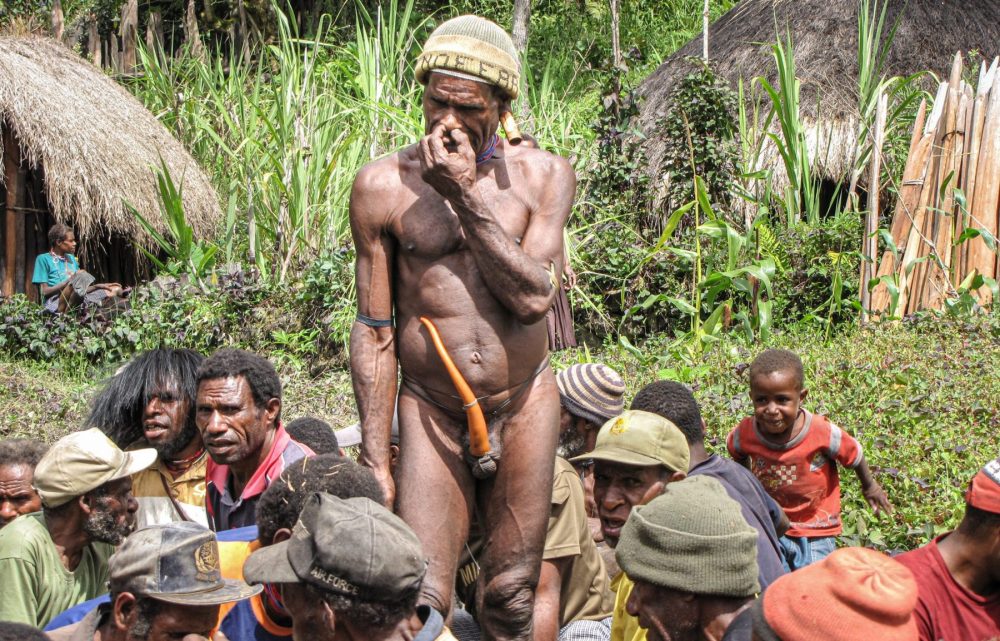
Villagers practicing a tradtional ritual to heal a sick man
More Penis Gourdes
I didn’t know what to expect from Prongolli but I figured if it was a larger village and would be less interesting, but I was surprised to discover that it would have the highest percentage of people wearing traditional clothes, male and female. It also had a larger Indonesian military presence. Again, we slept inside a schoolhouse and made a call to MAF requesting a plane to pick us up.
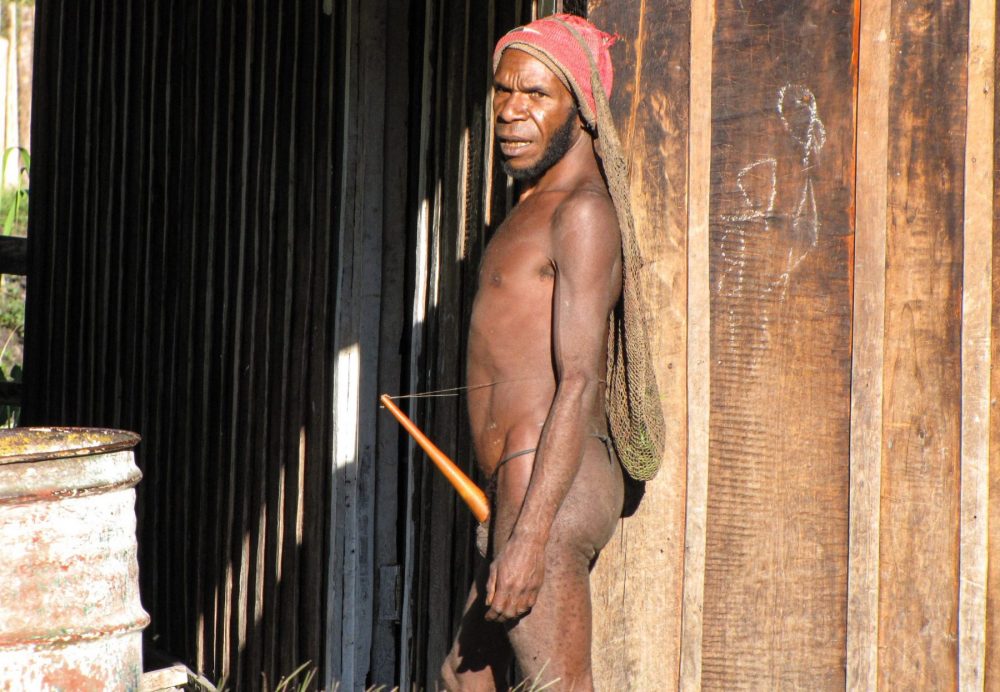
Yali man in Prongolli
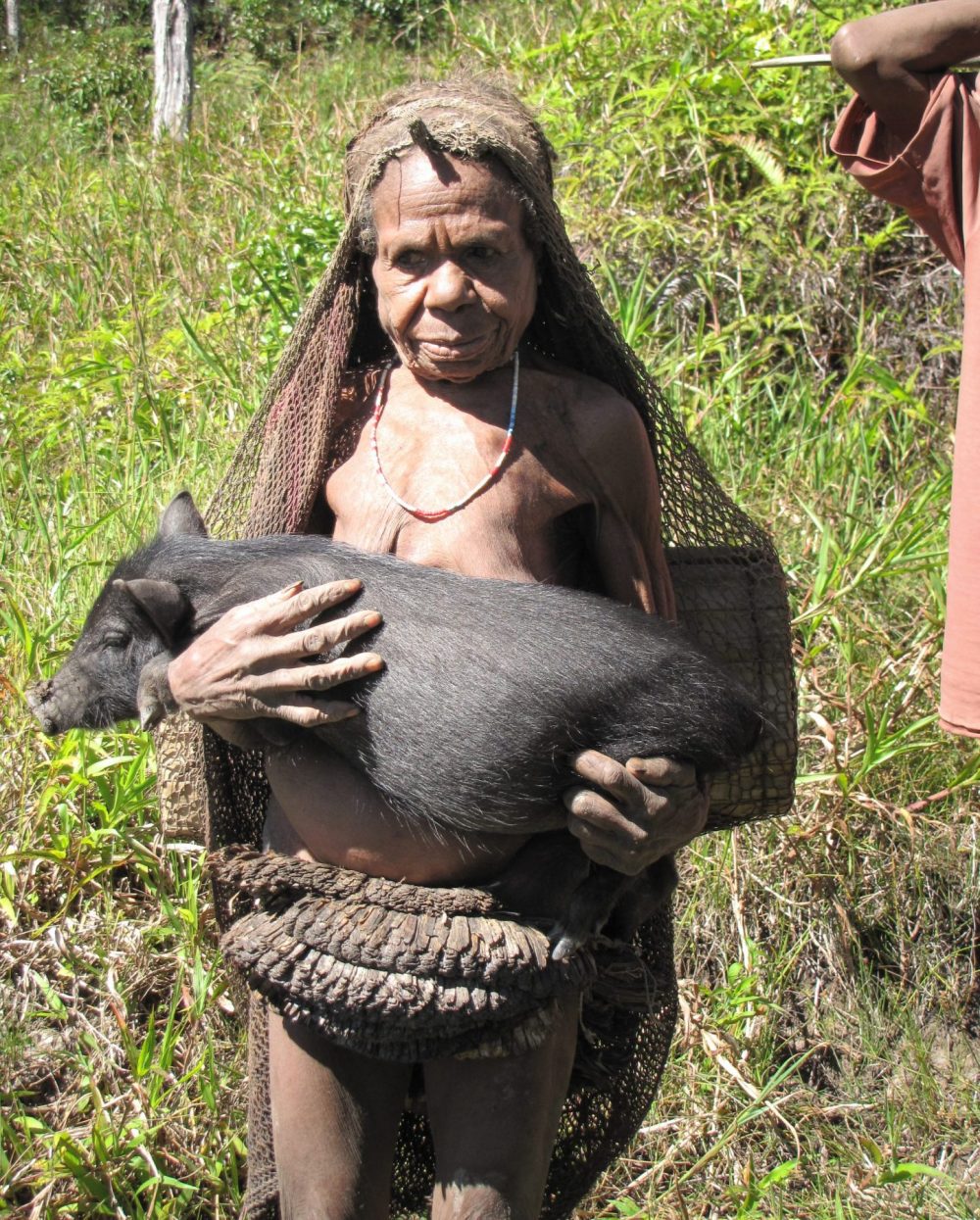
Yali woman with her pig

Yali boy
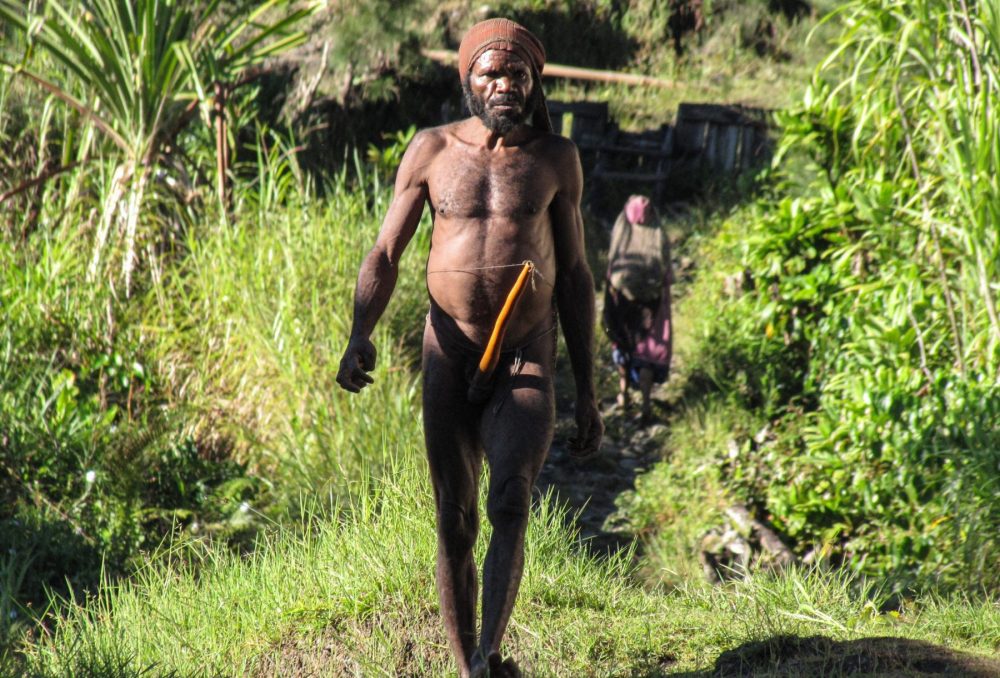
Yali man
Wandering around Prongolli was a photographer’s paradise. There were so many interesting photos to take of the people. Unfortunately, I also saw probably one of the most gruesome animal slaughters of my life. A Yali man surrounded by spectators poked a live pig with a knife to bleed it and the pig screamed in terror and pain. This scene continued for a few minutes, and it was obvious that the man was going to do this for as long as he could to prolong the torturous end for the pig. This method of killing a pig was what I had been seeing in Papua and believed to increase the flavor of the pig.

Spectators watching the pig slaughter

Man slowly killing a pig
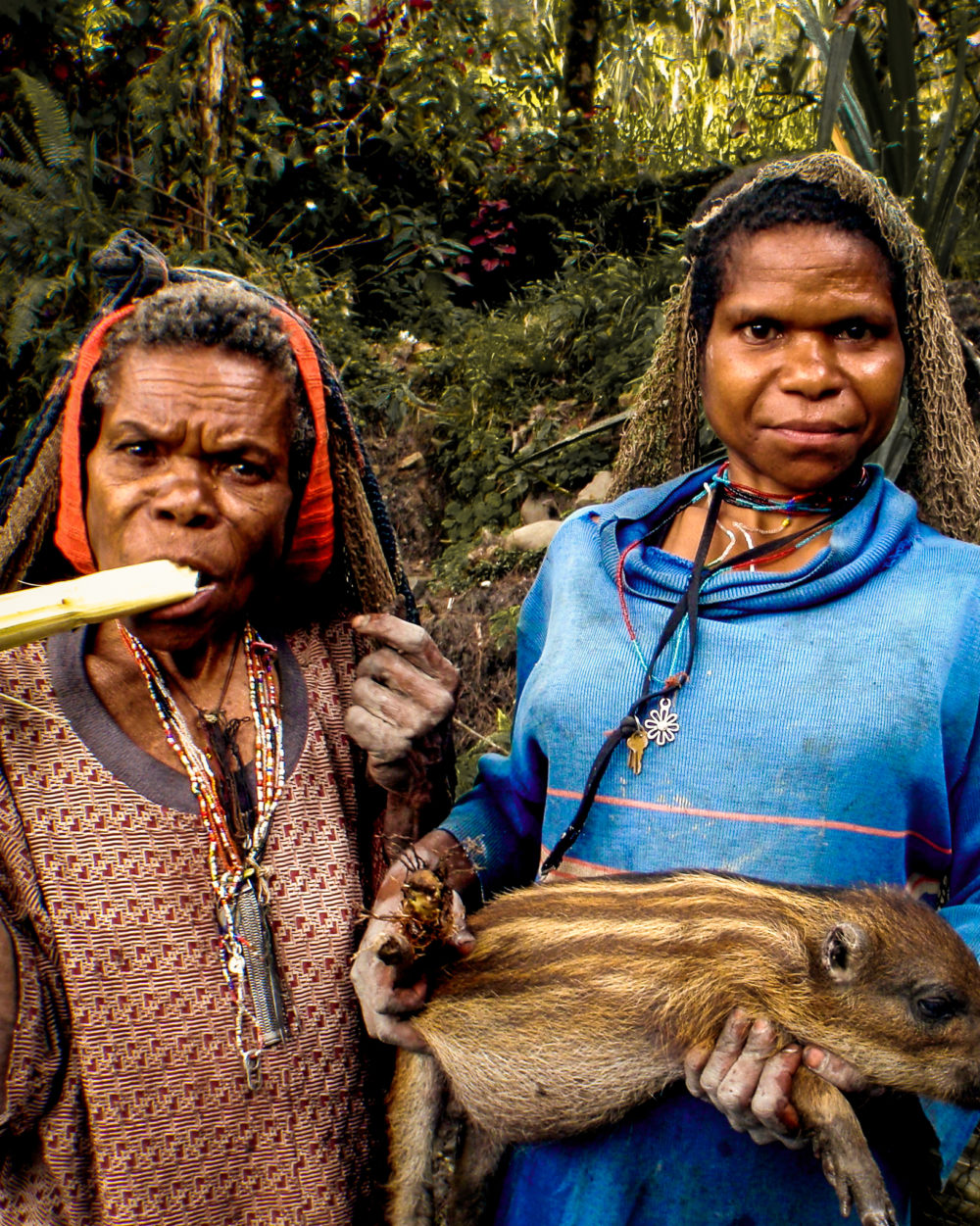
Village women
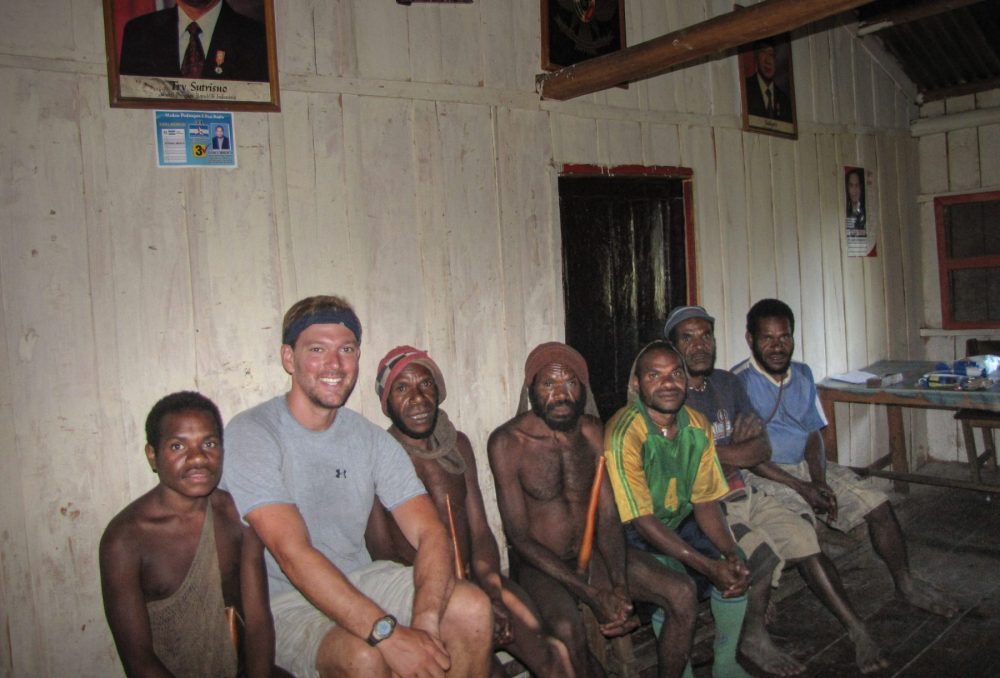
With our new friends in the schoolhouse we spent the night
The Long Hike Back
In the morning there was no sign of a MAF flight, an observation we were familiar with by now and we didn’t have enough days to make the hike back to Wamena unless we planned to hike at night too. We were distraught but there was no time to wallow in despair, we had to try and make it back on time and to do this we would need to dig deep and muster all the strength we had and more to make the journey, especially Kent, whose leg was feeling better, but still injured. A villager helped us by recommending a different trail that was considered slightly faster and different than the one we hiked in on. But the caveat was it would be more dangerous. We would need to climb up and over Mount Elit, with its huge stone face via a series of 6 ladders of about 5-8meters in length. The climb would take us half a day and it would be very treacherous. The goal was to find a cave in the face of the mountain to sleep in for the night.
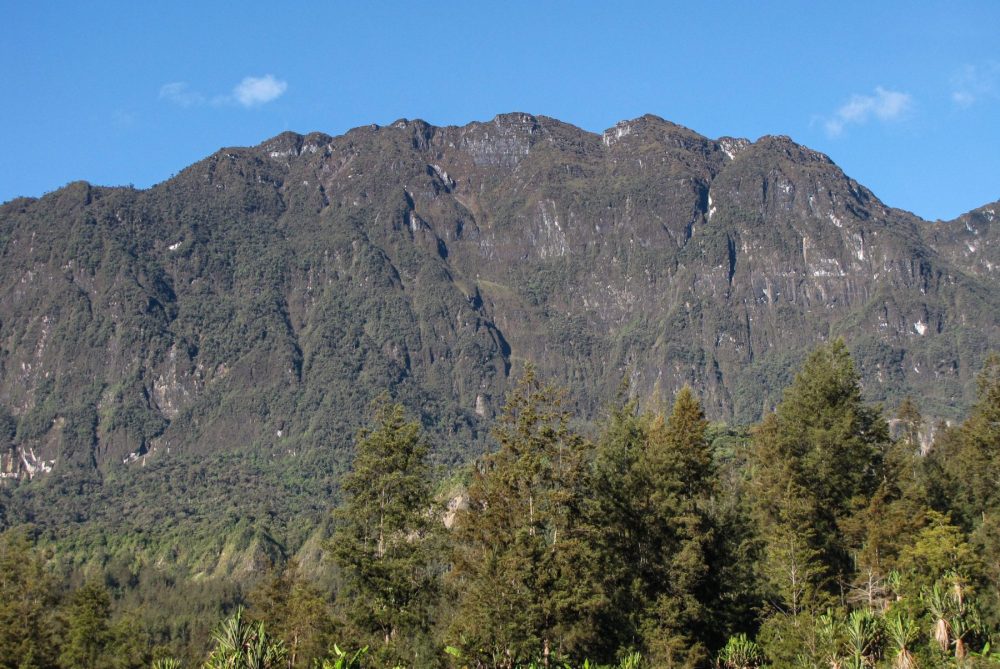
Mt. Elit-mountain we climbed

Hike through jungle to Mount Elit

me hiking to Mount Elit
The climb up the flimsy wooden ladders was invigorating and scary but I loved every minute of it. We neared the top of Mount Elit when we approached a small cave overlooking a sheer cliff. There were already a few people camping inside burning a fire for warmth. We found an open spot in the cave to set up our camp besides the others. It was a very exotic place to camp looking out over the valley from the top of the mountain.

Climbing the ladders
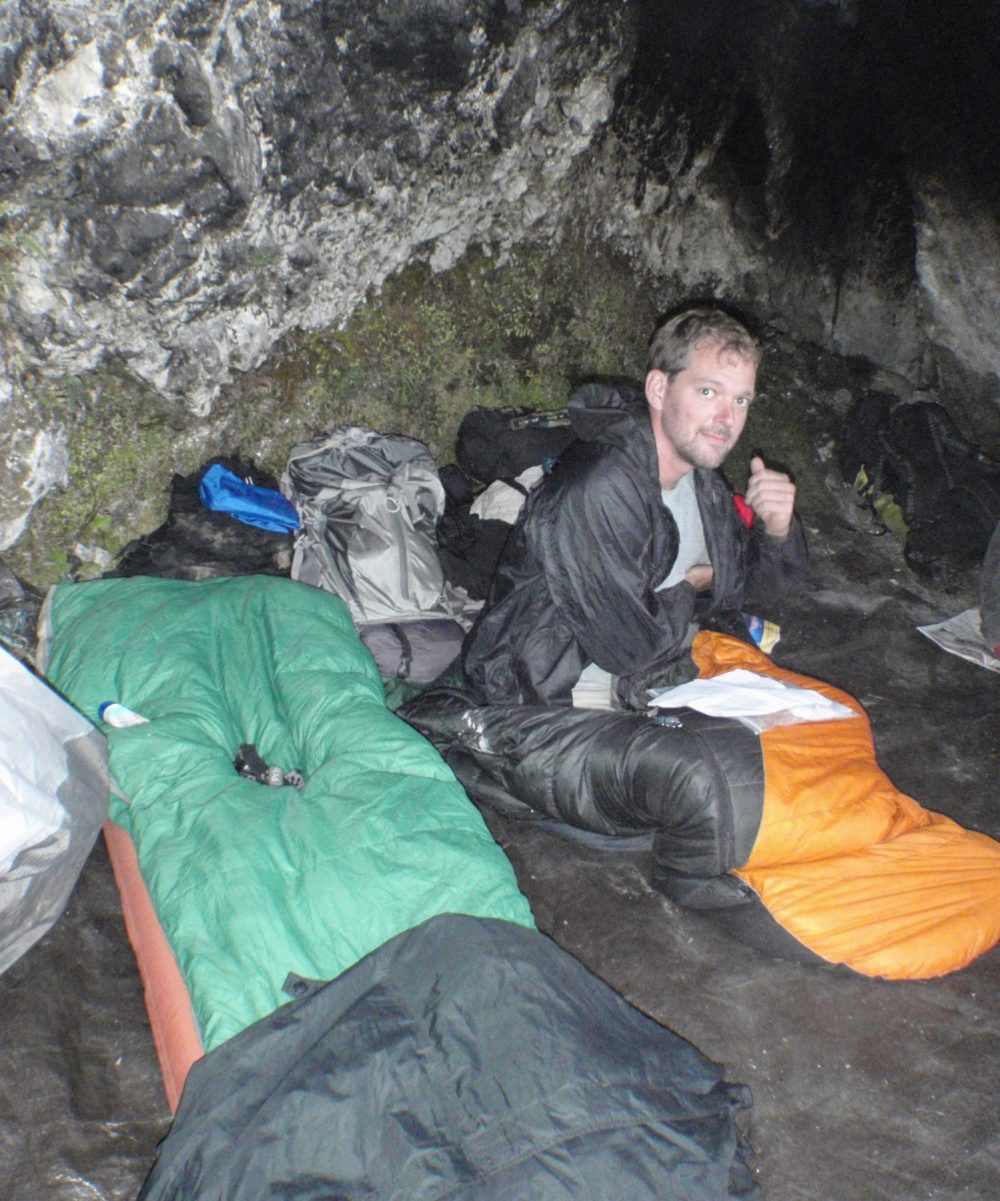
Sleeping inside the cave on the mountain top
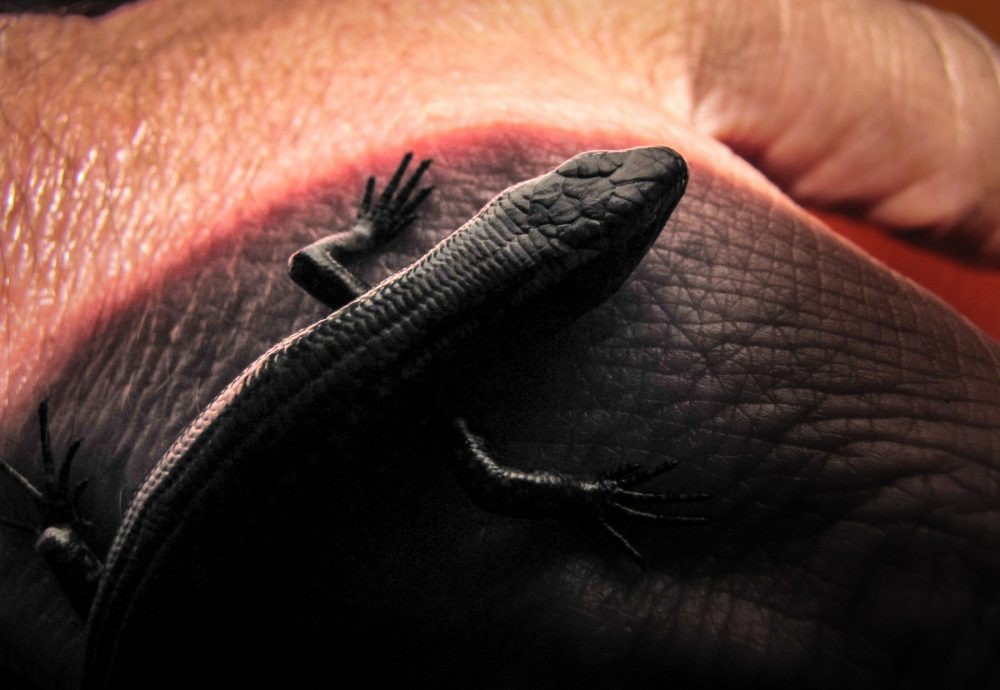
Lizard friend living inside the cave

Sleeping in the cave with other travelers
In the morning we had to climb some more ladders and then cross another peat swamp and wet forest. It was raining and freezing cold. We crossed many long sticks that were placed in the bog in a visible manner. Our guide explained that many people succumb to the cold on the mountain and these sticks are left to memorialize their deaths or serve as kind of a grave marker.

Peat swamp on Mount Elit
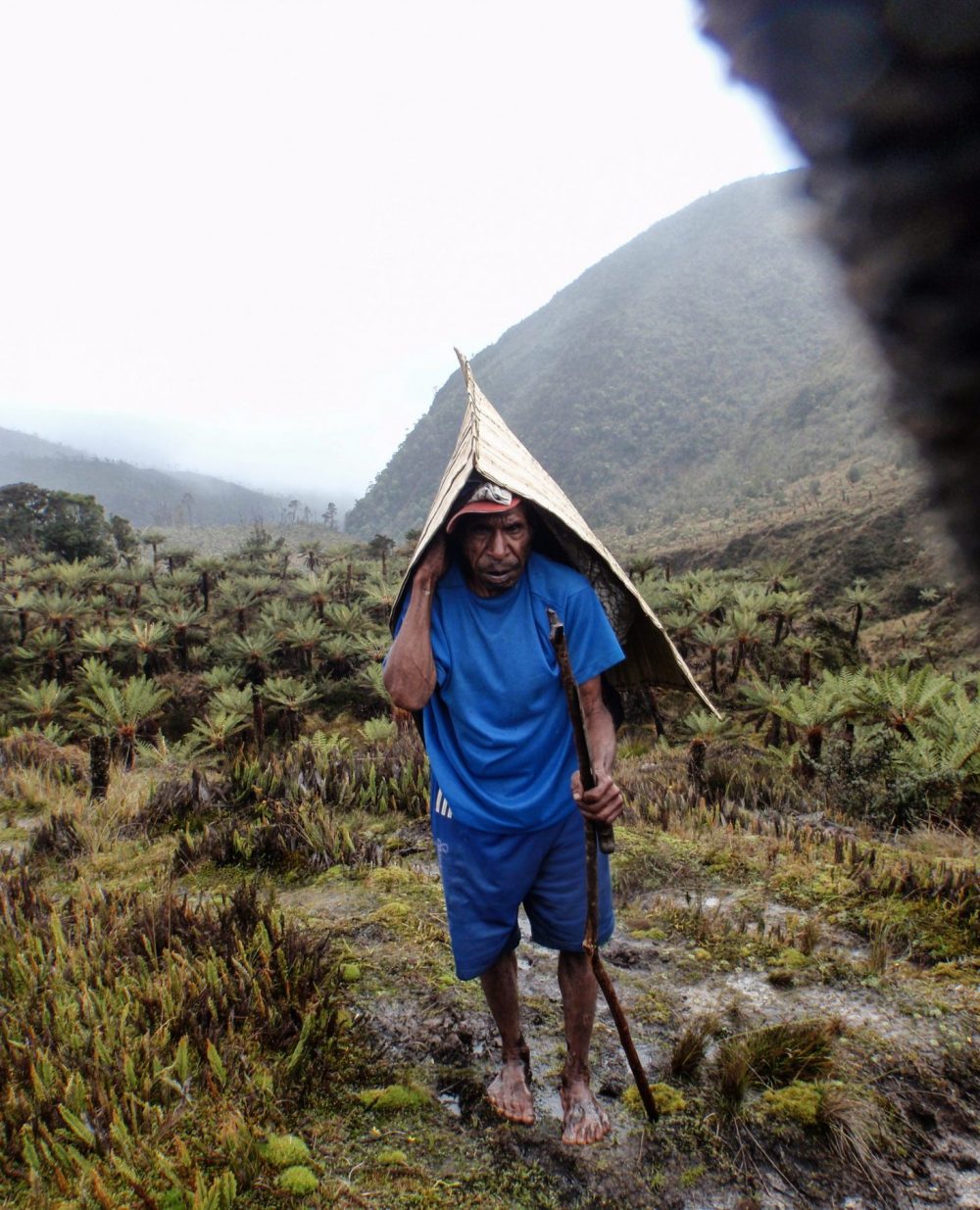
Yali man crossing the peat swamp barefoot

Yali people use panana leaves as rain coats
The End
On the otherwise of the mountain on or descent we had to cross multiple rivers that were deep and dangerous, and we left our shoes on to ensure and more sturdy footing during the crossing. The cost of doing so was having wet hiking boots but the rain was so heavy now that our shoes were wet anyways. We reached the bottom of Mount Elit and slept in our tents near a large shelter where dozens of local travelers were staying. Our guide and porter stayed inside the shelter. Kent and I tried to sleep in the shelter at first but the smoke, and screaming children was too much to bear so we set up our tents in the rain outside.
On the last day I hiked 20 plus miles through the mountains, and I was possessed with determination to race back to Wamena eventually hitchhiking the rest of the way to Wamena when we found the road and immediately buying our Trigana flight tickets to Jayapura before they sell out. I ended up arriving in Wamena late at night. I had secured two of the last tickets on the Trigana flight, a flight that always sells out quickly and now I just needed Kent to make the hike back and we were goo to go to catch out international flight on time. I was also in bad shape. I couldn’t swallow. My throat was on fire evidently from eating two weeks of readymade REI meals with lots of artificial ingredients that had caused me severed acid reflux that has left my throat on fire. It was a horrible feeling to be so hungry but to be unable to eat much and I would go on to lost approx. 20 pounds of weight.
The next morning Kent who fell behind me arrived in Wamena but he didn’t have time to relax as we had to go straight to the airport to catch our flight to Jayapura. While we stood in the check-in line, we saw another foreign looking man, a rare sight in this region and I started talking to him. Kent and I were in utter disbelief when he told us he was a MAF pilot, and that he was the polit that had been assigned to go to Prongolli to pick us up and that when he landed, we were already gone. We discovered that he came to pick us up only hours after we started trekking back to Wamena. We all had a good laugh over this since the hike was behind us and in retrospect, I am glad we did the hike back because it was tough but one of the most amazing treks I have ever done in my life, and I wouldn’t have traded it for anything. Kent and I spent one more night in Papua at Jayapura after our Trigana Air flight landed there before returning home via Jakarta.
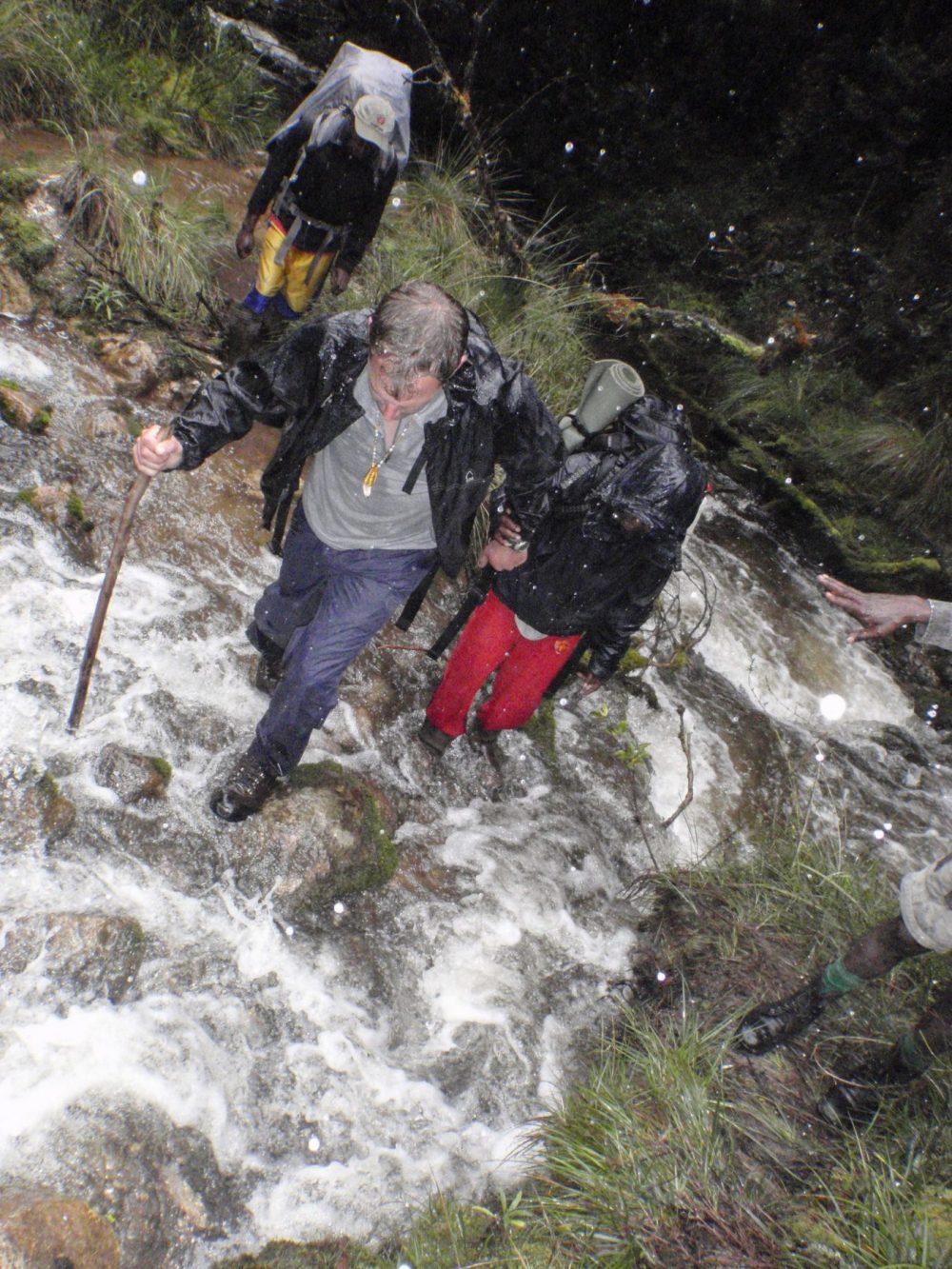
Me crossing a river
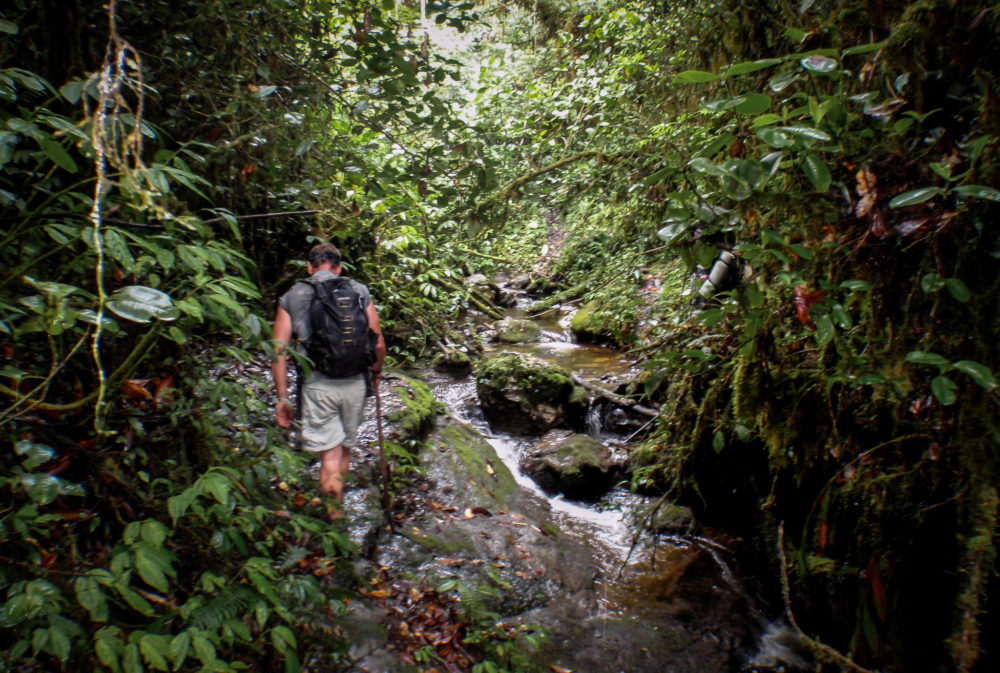
Me hiking in the jungle

